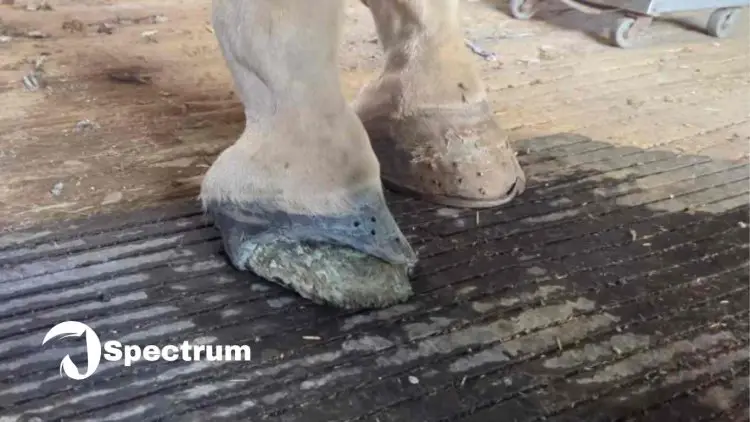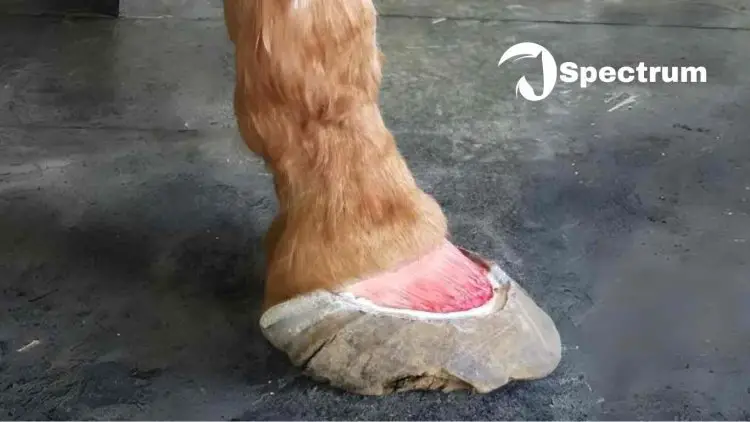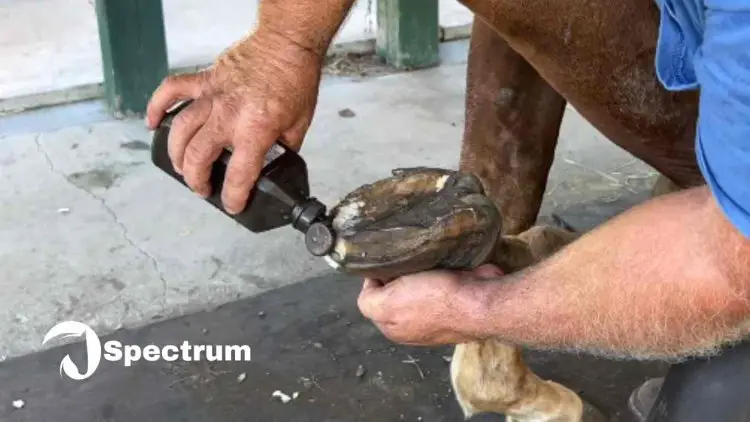Can You Ridе a Horsе with Whitе Linе Disеasе?
Explorе thе nuancеs of riding a horsе with White Line Disease in this comprеhеnsivе guidе. Lеarn about thе causеs, symptoms, and thе profound impact of White Line Disease on hoof hеalth. Dеlvе into thе quеstion: Is it safе to ridе a horsе with White Line Disease? Uncovеr thе potеntial dangеrs for both ridеr and horsе. Gain insights into diagnosing, trеating, and prеvеnting White Line Disease through еffеctivе hoof carе practices. Lеarn if you can trеat White Line Disease with blеach and trush bustеr.

Table of Contents
What is White Line Disease?

White Line Disease, also known as Onychomycosis, is a fungal infection that affects the innermost layer of the hoof wall, resulting in white line separation. This condition leads to the separation of the hoof wall from the underlying structures, compromising the overall integrity of the hoof. The most common cause of White Line Disease is prolonged exposure to moist and dirty environments which create the perfect conditions for fungal growth. Additionally, poor hoof care, improper shoeing, and trauma to the hoof can also contribute to the development of this condition.
Causes and Symptoms
White Line Disease is typically caused by a fungal invasion of the hoof wall, leading to the degradation of hoof horn tissue. The primary symptoms include wall separation, hoof cracks, lameness, and signs of laminitis, ultimately impacting the affected horse's hoof condition.
Impact on Hoof Health
White Line Disease significantly affects the overall hoof health, leading to the deterioration of the hoof structure and potentially exposing the coffin bone to external factors. The condition can result in lameness, compromising the horse's ability to perform and causing discomfort.
Risk Factors for Horse Owners
Horse owners need to be aware of the risk factors associated with White Line Disease, including poor hoof conformation, inadequate hoof care, and the potential for fungal infections, as these factors can contribute to the development and progression of the disease.
Riding a Horse with White Line Disease
Many horse owners may wonder whether it is safe to ride a horse affected by White Line Disease. Understanding the risks, impact on the horse's performance and behavior, and appropriate measures for riding and managing affected horses are essential considerations for equine health and well-being.
Is it Safe to Ride a Horse With White Line Disease?
Riding a horse with White Line Disease can be potentially dangerous for both the rider and the horse. White Line Disease affects the hoof and can cause lameness and discomfort for the horse. Riding a horse with this condition can exacerbate the problem and lead to further injury or lameness. It is important to consult with a veterinarian and a farrier to determine the best course of action for managing White Line Disease in a horse. Taking the necessary precautions and seeking professional guidance can help ensure the safety and well-being of both the horse and the rider.
Impact on Horse's Performance and Behavior
White Line Disease can have a significant impact on the horse's performance and behavior, potentially causing discomfort and affecting their ability to move comfortably. evaluating the impact of the disease on the horse's overall well-being is crucial for making informed decisions regarding riding and managing affected horses.
Related: Can You Ride A Horse With Hoof Abscess?
Diagnosing and Treating White Line Disease

Identifying Signs of White Line Disease
White Line Disease in horses can be identified by several key signs. One of the most common indicators is a separation or widening of the white line between the hoof wall and the sole. This can often be accompanied by a small area of bleeding or discharge in the affected area. Additionally, horses may show signs of lameness, tenderness, or reluctance to bear weight on the affected foot. Regular hoof care and inspections are important for catching and treating White Line Disease early.
Effective Treatment for White Line Disease

White Line Disease in horses can be effectively treated through a combination of proper trimming, good hygiene, and medication. The affected part of the hoof should be carefully cleaned and trimmed to remove any dead tissue and debris. This can help to eliminate the anaerobic environment in which the bacteria thrive. Regular cleaning and application of antifungal and antibacterial treatments, such as iodine solution or copper sulfate, can also help to control the spread of the infection. It is important to consult with a veterinarian or a professional farrier for an accurate diagnosis and to develop a treatment plan tailored to the specific needs of the horse. In some severe cases, where the infection has spread deep within the hoof, surgical intervention may be necessary. Overall, prompt and proactive management of White Line Disease can help to prevent further damage to the hoof and promote healing.
Proper Hoof Care to Prevent White Line Disease
Proper hoof care is essential in preventing White Line Disease in horses. Regular trimming and maintenance of the hooves, along with a balanced diet, can help keep the hooves healthy and strong. It is important to clean the hooves regularly and inspect for any signs of infection or damage. Providing a clean and dry environment for the horse, as well as avoiding prolonged exposure to wet conditions, can also contribute to preventing White Line Disease. Additionally, working with a knowledgeable farrier and veterinarian can help ensure that the horse's hooves are properly cared for and monitored for any potential issues.
FAQs
Can you shoe a horse with White Line Disease?
Shoeing a horse with White Line Disease requires careful consideration and collaboration between the farrier and the veterinarian. The primary goal of shoeing in such cases is to support the affected hoof, promote proper weight distribution, and minimize the risk of further damage to the hoof structure. The farrier may need to customize the shoeing approach to accommodate the specific needs of the horse with White Line Disease, ensuring that the hoof is adequately supported and protected during the healing process.
Does White Line Disease cause lameness?
White Line Disease can indeed cause lameness in affected horses. As the condition progresses, the separation of the hoof wall and the degradation of hoof horn tissue can lead to significant discomfort and compromised movement for the horse. Lameness may vary in severity depending on the extent of the disease and its impact on the hoof's structural integrity. Prompt diagnosis and appropriate treatment are crucial for managing the progression of lameness related to White Line Disease and ensuring the horse's well-being.
Does Thrush Buster work for White Line Disease?
Thrush Buster, a popular hoof care product designed to combat bacterial and fungal infections, may have limited efficacy in directly treating White Line Disease. While it can be beneficial in addressing thrush and certain bacterial hoof issues, the specialized nature of White Line Disease may necessitate targeted treatments specifically tailored for fungal invasion and the degradation of the hoof wall. Therefore, consulting with a veterinarian for a comprehensive treatment plan and utilizing appropriate medications is essential for managing White Line Disease effectively.
What home remedies can I use for White Line Disease?
While home remedies may provide some supplementary support for managing White Line Disease, they should not replace professional veterinary care and farrier intervention. Maintaining a clean and dry environment for the horse, implementing proper hoof hygiene practices, and utilizing natural antifungal agents, such as apple cider vinegar soaks, may offer additional support in the overall management of White Line Disease. However, it's crucial to seek guidance from veterinary professionals to ensure that home remedies are used in conjunction with proven treatment strategies.
Can you treat White Line Disease with bleach?
Using bleach to treat White Line Disease in horses is a controversial topic in the equine community. While some individuals may advocate for the use of diluted bleach as a topical treatment to address fungal issues, caution must be exercised due to the potential harmful effects on the sensitive hoof tissues. Overuse or improper application of bleach can lead to further damage and negatively impact the horse's hoof health. Consultation with a veterinarian and farrier is essential to explore safe and effective treatment options and avoid potential adverse effects on the affected hoof.
What's Your Reaction?

















